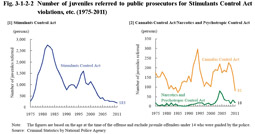2 Drug offenses
Poisonous and Deleterious Substances Control Act violations accounted for the vast majority of drug offenses committed by juveniles since the said Act was revised in 1972 to thereby criminalize paint-thinner abuse, etc. The number of juveniles referred to public prosecutors for violations of the said Act decreased sharply around 1993 after reaching a peak at 29,254 in 1982, and continued to decrease to be 112 in 2011 (down 57.6% from the previous year) (See Fig. 3-1-2-1 and Appendix 3-6).
Fig. 3-1-2-2 shows the number of juveniles referred to public prosecutors for violations of the Stimulants Control Act, Cannabis Control Act, and Narcotics and Psychotropic Control Act since 1975. The number of juveniles referred to public prosecutors for Stimulants Control Act violations sharply increased from 1975 and reached the record high level of 2,750 in 1982. In recent years, however, it was on a generally decreasing trend and was 183 in 2011 (down 19.4% from the previous year). That for Cannabis Control Act violations remained around 200 in recent years but significantly decreased to 81 in 2011 (down 50.6% (id.)). That for Narcotics and Psychotropic Control Act violations was on a generally decreasing trend from 2005, and was 18 in 2011 (down 45.5% (id.)).
Fig. 3-1-2-2 Number of juveniles referred to public prosecutors for Stimulants Control Act violations, etc. (1975-2011)
